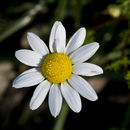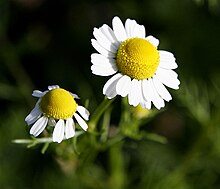ar
الأسماء في صفحات التنقل


Die Römischen Kamillen (Chamaemelum) sind eine Pflanzengattung in der Familie der Korbblütler (Asteraceae).
Chamaemelum-Arten sind einjährige oder ausdauernde, krautige Pflanzen. Die wechselständig angeordneten Laubblätter sind zwei- bis dreifach fiederschnittig mit linealischen Blattabschnitten.
Die Blütenkörbchen sind gestielt, mittelgroß. Die Hüllblätter stehen in zwei bis mehreren Reihen und werden von außen nach innen zu größer. Der flach gewölbte, halbkugelige bis kegelförmige Körbchenboden ist nicht hohl und mit stumpfen Spreublättern besetzt. Die Blütenkörbchen enthalten nur Röhrenblüten oder Röhren- und Zungenblüten. Zungenblüten sind meist vorhanden, weiblich oder steril. Ihre Kronröhre ist zweiflügelig, abgeflacht und hat eine abstehende, weiße, ganzrandige oder zwei- bis dreizähnige Zunge. Die Krone der Röhrenblüten ist gelb und trägt am Grund einen Fortsatz, der die Spitze der Frucht umschließt.
Die Achänen sind seitlich leicht zusammengedrückt und haben keine deutlichen Rippen. Ein Pappus fehlt.
Die Gattung Chamaemelum wurde 1754 durch Philip Miller in The Gardeners Dictionary...Abridged, 4. Auflage, Seite 315 aufgestellt. Ein Synonym für Chamaemelum Mill. ist Ormenis (Cass.) Cass. Die Gattung Chamaemelum gehört zur Subtribus Santolininae aus der Tribus Anthemideae in der Unterfamilie Asteroideae innerhalb der Familie Asteraceae.[1] Wie vielfach in dieser Tribus, ist die Zuordnung der Arten zu den Gattungen vielfach unklar und wechselt häufig. Die Artenzahlen für die Gattung reichen von zwei[2] bis sechs.[3]
Die beiden stets zur Gattung Chamaemelum gezählten Arten sind:[2][1]
Weiters werden teilweise folgende Arten zur Gattung Chamaemelum gerechnet:
Die Römischen Kamillen (Chamaemelum) sind eine Pflanzengattung in der Familie der Korbblütler (Asteraceae).
Chamaemelum is a small genus of plants in the daisy family commonly known as chamomiles or dogfennels. Perhaps the best-known species is Roman chamomile, Chamaemelum nobile. These are annual or perennial herbs, rarely exceeding half a meter in height and usually bearing solitary white daisylike flowers with yellow centers. They are native to Europe but most species can be found scattered in other continents where they have been introduced.[2][3] The genus consists of only two species and is of the Asteraceae family.[4]
Embryo sac development in Chamaemelum differs from that of Anthemis, with Chamaemelum exhibiting monosporic embryo sac formation, while all members of Anthemis have tetrasporic embryo sac. Anthemis and Chamaemelum have some differences in fruit and corolla structure, embryo sac development, and phytochemical data, and the closeness of their relationship has been debated.[5]
Chamaemelum was first mentioned by Linnaeus in ''Genera pIanta rum'' and had its generic name validated by Linnaeus in 1753 with the first edition of ''Species plantarum''. There was uncertainty surrounding the correct demarcation of the two genera, Anthemis (which used to be a name of Chamaemelum) and Anacyclus, for decades.[5]
Chamaemelum is a small genus of plants in the daisy family commonly known as chamomiles or dogfennels. Perhaps the best-known species is Roman chamomile, Chamaemelum nobile. These are annual or perennial herbs, rarely exceeding half a meter in height and usually bearing solitary white daisylike flowers with yellow centers. They are native to Europe but most species can be found scattered in other continents where they have been introduced. The genus consists of only two species and is of the Asteraceae family.
Embryo sac development in Chamaemelum differs from that of Anthemis, with Chamaemelum exhibiting monosporic embryo sac formation, while all members of Anthemis have tetrasporic embryo sac. Anthemis and Chamaemelum have some differences in fruit and corolla structure, embryo sac development, and phytochemical data, and the closeness of their relationship has been debated.
Chamaemelum was first mentioned by Linnaeus in ''Genera pIanta rum'' and had its generic name validated by Linnaeus in 1753 with the first edition of ''Species plantarum''. There was uncertainty surrounding the correct demarcation of the two genera, Anthemis (which used to be a name of Chamaemelum) and Anacyclus, for decades.
Chamaemelum es un género de plantas con flores (también conocidas como Angiospermas) perteneciente a la familia Asteraceae. Tiene 125 especies descritas y solo cuatro aceptadas.[2][3]
El género fue descrito por Philip Miller y publicado en The Gardeners Dictionary...Abridged...fourth edition vol. 1. 1754.[4] La especie tipo es Chamaemelum nobile (L.) All.
Chamaemelum: nombre genérico que deriva del griego chamai = "baja, enana", y melón = "manzana", que significa "manzana terrera"[5]
Chamaemelum es un género de plantas con flores (también conocidas como Angiospermas) perteneciente a la familia Asteraceae. Tiene 125 especies descritas y solo cuatro aceptadas.
Kampasauramot (Chamaemelum) on asterikasvien (Asteraceae) heimoon kuuluva kasvisuku. Sukuun luetaan nykyisin kuuluvaksi neljä lajia, joiden lisäksi sukuun on aikojen kuluessa kuvattu useita muitakin lajeja, mutta niiden taksonominen status on kuitenkin toistaiseksi epäselvä.[1]
Kampasauramot (Chamaemelum) on asterikasvien (Asteraceae) heimoon kuuluva kasvisuku. Sukuun luetaan nykyisin kuuluvaksi neljä lajia, joiden lisäksi sukuun on aikojen kuluessa kuvattu useita muitakin lajeja, mutta niiden taksonominen status on kuitenkin toistaiseksi epäselvä.
Chamaemelum est un petit genre de plantes de la famille des Asteraceae originaires d'Europe, mais la plupart des espèces sont présentes dans d'autres continents où elles ont été importées.
L'espèce la plus connue du genre est la camomille romaine (Chamaemelum nobile, anciennement Anthemis nobilis).
Ce sont des plantes vivaces ou annuelles, dépassant rarement 50 cm de hauteur et portant habituellement des fleurs (capitules) solitaires blanches à centre jaune ressemblant à la marguerite commune.
Chamaemelum est un petit genre de plantes de la famille des Asteraceae originaires d'Europe, mais la plupart des espèces sont présentes dans d'autres continents où elles ont été importées.
L'espèce la plus connue du genre est la camomille romaine (Chamaemelum nobile, anciennement Anthemis nobilis).
Blezdingūnė (Chamaemelum) – astrinių (Asteraceae) šeimos augalų gentis, kurioje vienintelė Lietuvoje retai auginama rūšis – kilnioji blezdingūnė (Chamaemelum nobile, sin. Arthemis nobilis). Vikiteka
Chamaemelum é um género botânico pertencente à família Asteraceae.[1]
Chamaemelum é um género botânico pertencente à família Asteraceae.
Chamaemelum là một chi thực vật có hoa trong họ Cúc (Asteraceae).[1]
Chi Chamaemelum gồm các loài:
Chamaemelum là một chi thực vật có hoa trong họ Cúc (Asteraceae).
Chamaemelum Mill., 1754
Хамеме́люм (лат. Chamaemélum) — небольшой род травянистых растений семейства Астровые (Asteraceae). Самый известный представитель — типовой вид рода Ромашка римская (Chamaemelum nobile), популярное лекарственное растение в народной медицине.
Научное латинское название рода произошло от греческих слов, обозначающих «маленький» и «яблоко», что объясняется слабым ароматом цветков, напоминающим запах спелых яблок[2].
Род включает два вида[3]:
Хамеме́люм (лат. Chamaemélum) — небольшой род травянистых растений семейства Астровые (Asteraceae). Самый известный представитель — типовой вид рода Ромашка римская (Chamaemelum nobile), популярное лекарственное растение в народной медицине.
Научное латинское название рода произошло от греческих слов, обозначающих «маленький» и «яблоко», что объясняется слабым ароматом цветков, напоминающим запах спелых яблок.

カマエメルム属(学名:Chamaemelum )は、キク科の中の、一年草と常緑の多年草4種からなる属である。
ヨーロッパ、地中海沿岸地域を原産地とし、北アフリカ、西アジアなどにも広く自生している。 属名はギリシャ語のchamaimelon (大地のリンゴ)からくる。リンゴのような芳香がする葉を持ち、デイジーのような花を咲かせる。
ハーブとして重要なのは、ローマンカモミール(Chamaemelum nobile) だけであり、カモミールティーとしてハーブティーや、薬用としても利用される。密生すると草地になり、芝生として利用しやすい花が咲かないChamaemelum nobile ‘Treneague' という園芸品種もある。